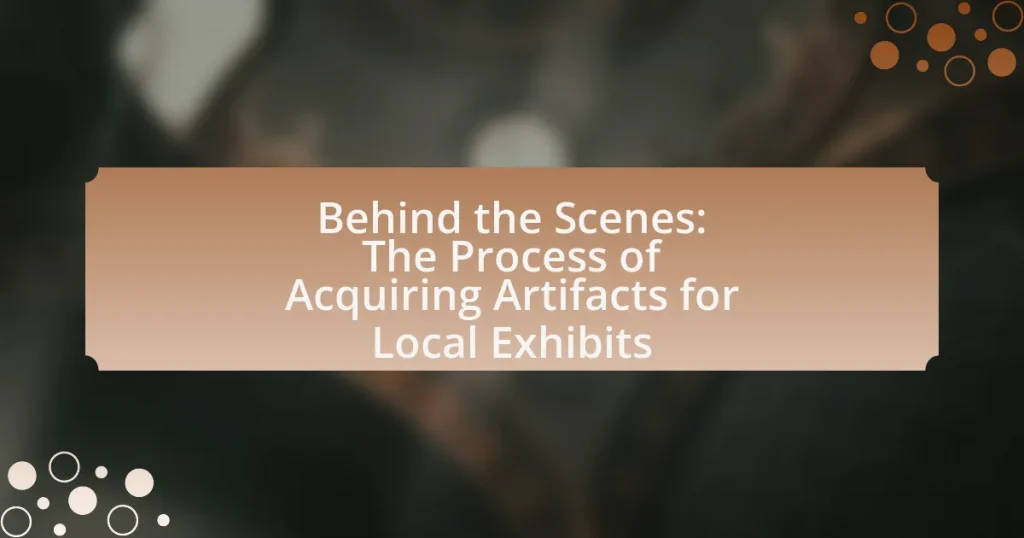The main entity of the article is the process of acquiring artifacts for local exhibits. The article outlines the systematic steps involved in this process, including research, negotiation, and documentation, emphasizing the importance of provenance and ethical considerations. It discusses how museums and galleries identify potential artifacts, the criteria used for evaluation, and the challenges institutions face, such as financial constraints and legal issues. Additionally, the article highlights the benefits of acquired artifacts for local communities, including educational opportunities and enhanced visitor engagement, while also addressing best practices for responsible acquisition and the significance of community involvement.
What is the process of acquiring artifacts for local exhibits?
The process of acquiring artifacts for local exhibits involves several key steps, including research, negotiation, and documentation. Initially, curators identify potential artifacts that align with the exhibit’s theme, conducting thorough research to understand their historical significance and provenance. Following this, curators negotiate terms with the artifact owners or lenders, which may include agreements on loan duration, insurance, and transportation. Finally, all agreements are documented to ensure legal compliance and to maintain a clear record of the artifact’s ownership and condition. This structured approach ensures that the artifacts are authentic, relevant, and properly cared for during the exhibit.
How do museums and galleries identify potential artifacts?
Museums and galleries identify potential artifacts through a systematic evaluation process that includes research, provenance verification, and expert consultation. This process begins with curators and collections managers conducting thorough research on items of interest, assessing their historical significance, cultural relevance, and condition. Provenance verification ensures that the artifact’s history is documented and legitimate, which is crucial for ethical acquisition. Additionally, experts in specific fields may be consulted to provide insights on the artifact’s authenticity and value. This multi-faceted approach helps institutions make informed decisions about which artifacts to acquire for their collections.
What criteria are used to evaluate artifacts for acquisition?
The criteria used to evaluate artifacts for acquisition include historical significance, condition, provenance, and relevance to the institution’s mission. Historical significance assesses the artifact’s importance in relation to specific events or cultural narratives. Condition evaluates the physical state of the artifact, determining if it can be preserved and displayed. Provenance establishes the artifact’s history of ownership, ensuring authenticity and ethical acquisition. Relevance to the institution’s mission ensures that the artifact aligns with the educational and cultural goals of the organization, enhancing its collection’s overall narrative.
How do cultural and historical significance influence artifact selection?
Cultural and historical significance directly influence artifact selection by guiding curators in identifying items that represent key narratives and values of a community. Curators prioritize artifacts that embody cultural heritage, historical events, or social movements, ensuring that the selected items resonate with the audience and reflect the collective identity of the society. For instance, artifacts from significant historical events, such as the Civil Rights Movement, are chosen to educate and engage the public, highlighting their importance in shaping contemporary values and understanding. This selection process is supported by research indicating that artifacts with strong cultural ties foster a sense of belonging and continuity within communities, thereby enhancing the educational impact of local exhibits.
What steps are involved in the acquisition process?
The acquisition process involves several key steps: identifying potential artifacts, evaluating their significance, negotiating terms, and finalizing the acquisition. Initially, curators or acquisition teams identify artifacts that align with the exhibit’s theme or educational goals. Following identification, they assess the historical, cultural, or artistic value of the artifacts to ensure they meet the institution’s standards. Once evaluated, negotiations take place with the artifact owners or sellers to agree on terms, including price and conditions of transfer. Finally, the acquisition is formalized through contracts or agreements, ensuring legal ownership and proper documentation for the institution’s records.
How do negotiations with artifact owners take place?
Negotiations with artifact owners typically occur through direct communication, often initiated by institutions seeking to acquire items for exhibits. These discussions involve outlining the terms of the loan or purchase, including duration, conditions for display, and financial compensation. Institutions may present their case by highlighting the significance of the artifact to the exhibit and the benefits to the owner, such as increased visibility and preservation efforts. Successful negotiations often rely on building trust and establishing a mutually beneficial relationship, supported by formal agreements that detail responsibilities and expectations.
What legal considerations must be addressed during acquisition?
Legal considerations during acquisition include due diligence, title verification, and compliance with applicable laws. Due diligence involves assessing the legal status of the artifact, ensuring that it is not stolen or subject to restitution claims. Title verification confirms that the seller has the legal right to transfer ownership. Compliance with laws such as the Cultural Property Implementation Act and international treaties like the UNESCO Convention is essential to avoid legal repercussions. These considerations are critical to ensure that the acquisition process is legally sound and ethically responsible.
Why is provenance important in acquiring artifacts?
Provenance is important in acquiring artifacts because it establishes the history of ownership and authenticity of the item. This historical record helps to verify that the artifact has not been stolen or illegally obtained, which is crucial for ethical collecting practices. Provenance also enhances the artifact’s value and significance, as items with well-documented histories are often more desirable to collectors and institutions. For example, the provenance of the Elgin Marbles has been a subject of debate, impacting their status and the discussions surrounding their repatriation.
What role does provenance play in establishing authenticity?
Provenance plays a critical role in establishing authenticity by providing a documented history of an artifact’s ownership and origin. This documentation helps verify the legitimacy of the artifact, as it traces its journey from creation to the present, often including details such as previous owners, sales records, and exhibition history. Provenance is essential in the art world, where forgeries and misattributions are common; a well-documented provenance can significantly enhance an artifact’s value and credibility. For instance, the sale of a painting attributed to a renowned artist can be validated through its provenance, which may include auction records or gallery exhibitions that confirm its authenticity.
How can provenance affect the value of an artifact?
Provenance significantly affects the value of an artifact by establishing its authenticity, historical significance, and ownership history. Artifacts with well-documented provenance are often more desirable to collectors and institutions, as they provide assurance that the item is genuine and not a forgery. For example, an artifact with a clear chain of ownership, such as being part of a notable collection or having been exhibited in prestigious museums, can command higher prices at auctions. Additionally, provenance can reveal the cultural and historical context of the artifact, enhancing its appeal and value. In the art market, pieces with documented provenance have been shown to sell for up to 50% more than those without, underscoring the critical role provenance plays in determining value.
What challenges do institutions face in acquiring artifacts?
Institutions face several challenges in acquiring artifacts, including financial constraints, legal issues, and provenance verification. Financially, many institutions operate on limited budgets, making it difficult to compete for high-value items in the market. Legally, institutions must navigate complex regulations regarding ownership and export laws, which can hinder acquisition efforts. Additionally, verifying the provenance of artifacts is crucial to ensure they are not stolen or illegally obtained, adding another layer of difficulty to the acquisition process. These challenges collectively impact the ability of institutions to build and maintain diverse and representative collections.
How do budget constraints impact the acquisition process?
Budget constraints significantly limit the acquisition process by restricting the financial resources available for purchasing artifacts. These limitations force organizations to prioritize certain acquisitions over others, often leading to a focus on lower-cost items or those that align closely with budgetary goals. For instance, a museum with a limited budget may opt to acquire fewer high-value artifacts, which can impact the diversity and richness of its exhibits. Additionally, budget constraints can necessitate negotiations with sellers to lower prices or seek alternative funding sources, such as grants or donations, to facilitate acquisitions. This financial pressure ultimately shapes the overall strategy and effectiveness of the acquisition process in local exhibits.
What strategies can institutions use to overcome financial limitations?
Institutions can overcome financial limitations by diversifying funding sources, such as grants, donations, and partnerships. For instance, many museums and cultural institutions successfully apply for grants from organizations like the National Endowment for the Arts, which awarded over $27 million in grants in 2021 alone, supporting various projects and initiatives. Additionally, forming partnerships with local businesses can lead to sponsorship opportunities, enhancing financial stability while fostering community engagement. Engaging in fundraising events and campaigns can also generate revenue, as seen in successful initiatives where institutions raised significant amounts through community-driven efforts. These strategies collectively enable institutions to navigate financial challenges effectively.
How does competition among institutions affect artifact availability?
Competition among institutions increases artifact availability by driving them to acquire unique items to attract visitors and enhance their collections. This competitive environment encourages institutions to actively seek out artifacts through purchases, loans, or donations, often leading to more diverse and accessible collections. For instance, museums may collaborate with private collectors or other institutions to secure rare items, thereby expanding their offerings. Additionally, the presence of multiple institutions vying for the same artifacts can lead to bidding wars, which may increase the overall availability of artifacts in the market as sellers respond to heightened demand.
What ethical considerations arise during the acquisition of artifacts?
Ethical considerations during the acquisition of artifacts include provenance, cultural sensitivity, and legal compliance. Provenance refers to the documented history of an artifact, which is crucial to ensure it was not obtained through illegal means or looting. Cultural sensitivity involves respecting the cultural significance of artifacts to their originating communities, which may require consultation and collaboration with those communities. Legal compliance ensures that the acquisition adheres to national and international laws regarding cultural heritage and property rights, such as the UNESCO Convention on the Means of Prohibiting and Preventing the Illicit Import, Export, and Transfer of Ownership of Cultural Property. These considerations are essential to maintain integrity and respect in the acquisition process.
How do institutions ensure responsible sourcing of artifacts?
Institutions ensure responsible sourcing of artifacts by implementing strict acquisition policies that prioritize ethical considerations and provenance verification. These policies often require thorough documentation of an artifact’s history, including its origin and previous ownership, to confirm that it was obtained legally and ethically. Additionally, institutions may collaborate with cultural heritage organizations and adhere to international guidelines, such as the UNESCO Convention, which promotes the protection of cultural property and discourages illicit trade. By following these practices, institutions can maintain transparency and accountability in their acquisition processes, thereby fostering trust within the communities they serve.
What are the implications of acquiring artifacts from contested origins?
Acquiring artifacts from contested origins raises ethical, legal, and cultural implications. Ethically, it can perpetuate historical injustices and undermine the rights of indigenous or local communities who may claim ownership or cultural significance of the artifacts. Legally, such acquisitions may violate international laws and agreements, such as the UNESCO Convention on the Means of Prohibiting and Preventing the Illicit Import, Export, and Transfer of Ownership of Cultural Property, which aims to protect cultural heritage. Culturally, acquiring these artifacts can lead to tensions between institutions and source communities, as it may be perceived as a form of cultural appropriation or exploitation. These implications highlight the need for careful consideration and dialogue when engaging in the acquisition of artifacts with contested origins.
How do local exhibits benefit from acquired artifacts?
Local exhibits benefit from acquired artifacts by enhancing educational value and cultural significance. Acquired artifacts provide tangible connections to history, allowing visitors to engage with the past in a meaningful way. For instance, a local museum showcasing artifacts from a specific historical event can offer insights into that event’s impact on the community, thereby fostering a deeper understanding among visitors. Additionally, artifacts can attract more visitors, as unique items often generate interest and increase foot traffic, which can lead to higher revenue for the exhibit. Studies have shown that exhibits featuring authentic artifacts can improve visitor retention and satisfaction, as they create immersive experiences that resonate with audiences.
What educational opportunities do artifacts provide for local communities?
Artifacts provide educational opportunities for local communities by serving as tangible connections to history, culture, and science. They facilitate hands-on learning experiences, allowing community members to engage with their heritage and understand the significance of their local narratives. For instance, museums often organize workshops and guided tours that utilize artifacts to teach about historical events, traditional practices, and scientific principles, enhancing the educational experience. Research indicates that communities with access to local artifacts report increased cultural awareness and pride, as evidenced by studies showing that educational programs centered around artifacts can improve knowledge retention and foster community engagement.
How can artifacts enhance visitor engagement and experience?
Artifacts enhance visitor engagement and experience by providing tangible connections to history and culture. When visitors interact with artifacts, they can better understand the context and significance of the items, which fosters a deeper emotional and intellectual connection. For instance, studies have shown that physical objects can evoke curiosity and stimulate discussion among visitors, leading to a more immersive experience. Additionally, artifacts often serve as focal points in exhibits, drawing attention and encouraging exploration, which can increase the time spent in a venue and enhance overall satisfaction.
What best practices should institutions follow when acquiring artifacts?
Institutions should follow best practices such as conducting thorough provenance research, ensuring legal compliance, and assessing the condition of artifacts before acquisition. Provenance research verifies the history of ownership, which is crucial for establishing authenticity and ethical acquisition. Legal compliance involves adhering to laws and regulations regarding cultural heritage and ownership rights, ensuring that artifacts are not obtained through illicit means. Additionally, assessing the condition of artifacts helps institutions understand preservation needs and potential restoration costs, which is essential for responsible stewardship. These practices are supported by guidelines from organizations like the American Alliance of Museums, which emphasize ethical standards in artifact acquisition.
How can institutions build relationships with artifact donors and collectors?
Institutions can build relationships with artifact donors and collectors by establishing clear communication and demonstrating appreciation for their contributions. Regularly engaging with donors through personalized outreach, such as thank-you letters and invitations to events, fosters a sense of connection. Additionally, providing transparency about how their artifacts will be used and showcasing them in exhibitions can enhance trust and encourage ongoing support. Research indicates that institutions that actively involve donors in the curation process see increased donor satisfaction and retention, as evidenced by case studies from various museums that report higher engagement levels when donors feel valued and informed.
What role does community involvement play in the acquisition process?
Community involvement is crucial in the acquisition process as it fosters collaboration between institutions and local stakeholders, enhancing the relevance and authenticity of the artifacts collected. Engaging the community allows for the identification of culturally significant items that reflect local history and values, ensuring that exhibits resonate with the audience. For instance, studies have shown that museums that actively involve community members in acquisition decisions report higher visitor satisfaction and increased community support, as these artifacts often tell stories that are meaningful to local residents.















